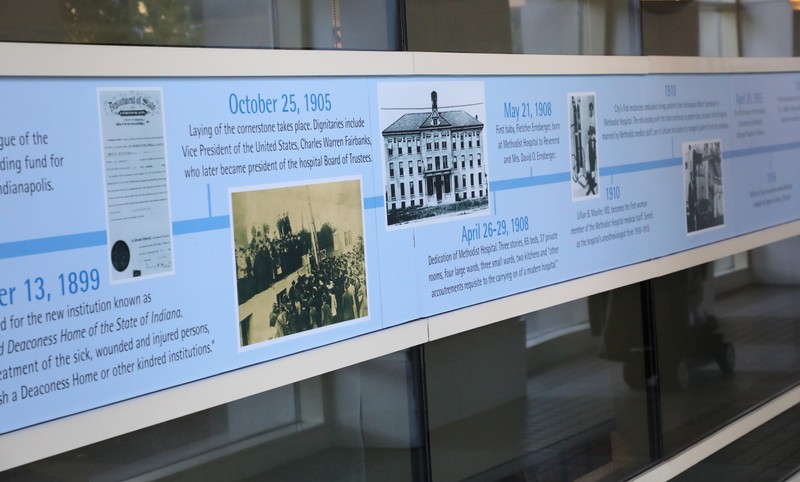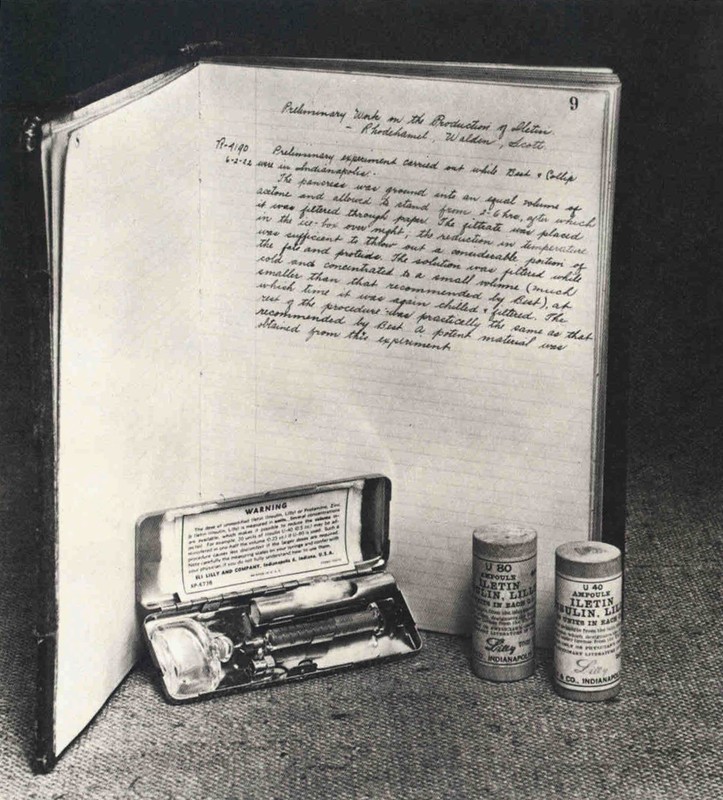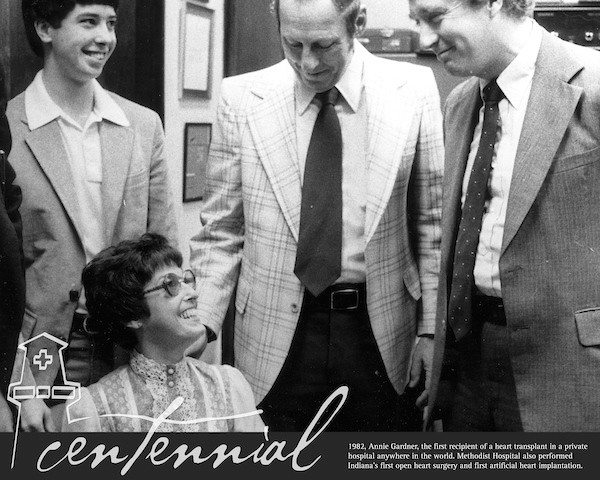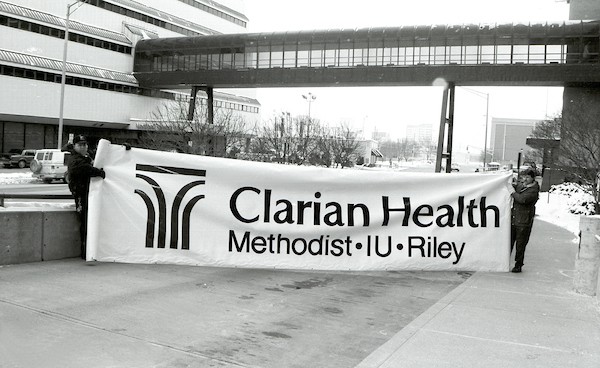Timeline
Introduction
Text-to-speech Audio
To commemorate their 100th anniversary, Methodist Hospital installed a timeline in the walkway between the hospital lobby and the main parking garage. The timeline has sixty-three entries; it begins with the Epworth Convention in 1899 and ends with the year-long centennial celebration of the history of Methodist Hospital. The timeline is an excellent surface-level overview of the history of Methodist Hospital.
Images
Methodist Hospital Timeline

Insulin History

First Heart Transplantation

Clarian Consolidation

Backstory and Context
Text-to-speech Audio
IU Health has had a storied history; it grew from a small Methodist hospital into the largest health network in Indiana. This entry will highlight three main events: early insulin tests on patients with diabetes (1922), the first successful heart transplant (1982), and the merger into Clarian Health Partners (1997).
Early Insulin Tests
After experimenting with dogs and themselves, Canadian surgeon Dr. Frederick G. Banting and student assistant Charles Best determined that insulin can be used to treat diabetes. In December of 1921, Banting and Best lectured about their experiment and findings in New Haven, Connecticut. Among the attendees was George Henry Alexander Clowes, head of research staff of the pharmaceutical company Eli Lilly. After the lecture, Clowes convinced Banting and Best that Eli Lilly could help them purify and stabilize their insulin to make it available in sufficient quantities. The Lilly Company immediately committed $250,000 to the effort. In early August 1922, some of the first units of Lilly manufactured insulin were given to patients at Methodist Hospital and by Dr. Elliot P. Joslin in Boston. At Methodist, Nellie Underwood, a long-time housekeeper and two unknown patients were the first to receive insulin. They were closely monitored around the clock with vitals checked every half hour; no significant side effects were reported. Over the next year, Methodist became one of ten regional hospitals where insulin was available for limited testing. By the end of 1923, when insulin was officially placed on the widespread market, Methodist Hospital had already treated 135 diabetic patients. As a result of Methodist’s pioneering efforts, the Hospital solidified itself on the national medical map.
First successful heart transplant
On October 30, 1982, after four years of preparation, Methodist Hospital completed the first successful heart transplant at a non-medical school hospital. Thirty-eight-year-old Crawfordsville resident, Mrs. Annie Gardner, was the patient, and cardiovascular surgeon Dr. Harold Halbrook performed the operation. A visiting surgeon from Palo Alto, California, assisted him. As a result of Mrs. Gardner’s serious condition, Dr. William Storer, her physician, placed her on a list of possible heart transplant recipients. On the morning of the surgery, Dr. Halbrook notified her that a donor had become available. That afternoon she arrived at the hospital to prepare for the operation. The successful surgery took four hours. Mrs. Gardner’s operation was the first of eleven heart transplants to be performed at Methodist Hospital during the next two years.
Foundation of Clarian Health Partners
In the midst of murmurings of healthcare reforms during the Clinton Presidency, Methodist Hospital decided to move toward integrated healthcare delivery to help fight rising costs. As a result, the Methodist Health Group was formed to unite Methodist Hospital with the expanding satellite medical centers. In 1996, hospital integration took another significant step when Methodist Hospital, Indiana University Hospital, and Riley Children’s Hospital announced a $1.1 billion consolidation. The CEO of Methodist Hospital, William (Bill) Loveday, was promoted to CEO of the new organization. Thirteen members would occupy the new organization’s board; the following formula assigned them. The IU Board of Trustees, Methodist Health Group, Dean of the IU School of Medicine, Bishop of the Indiana Area United Methodist Church, and the CEO would each name one member. The remaining eight would be selected jointly by the IU Board of Trustees and the Methodist Health Group. The proposed merger recognized that each of the three hospitals would maintain their names but be united as one organization. A committee was established with members from each represented hospital along with outside consultants to name the organization. The committee landed on the name Clarian, drawn from the Latin root clarius, meaning distinct, bright, clear, and distinguished. Clarian Health Partners officially launched on January 1, 1997. In 2011, Clarain was rebranded to IU Health to reflect their relationship with Indiana University and the IU School of Medicine.
Sources
Reed, Kenneth E. and Leary, Edward A. A History of Methodist Hospital of Indiana Inc.: A Mission of Compassionate Heath Care. Indianapolis, IN, 2007 https://indianamemory.contentdm.oclc.org/digital/collection/HIUH/id/556
Newspapers Consulted:
Indianapolis Star
Indianapolis News
Materials in IU Health Archives Consulted:
Board and Committee Minutes
The Beacon Newsletter
IU Health Archives
IU Health Archives
IU Health Archives
IU Health Archives
